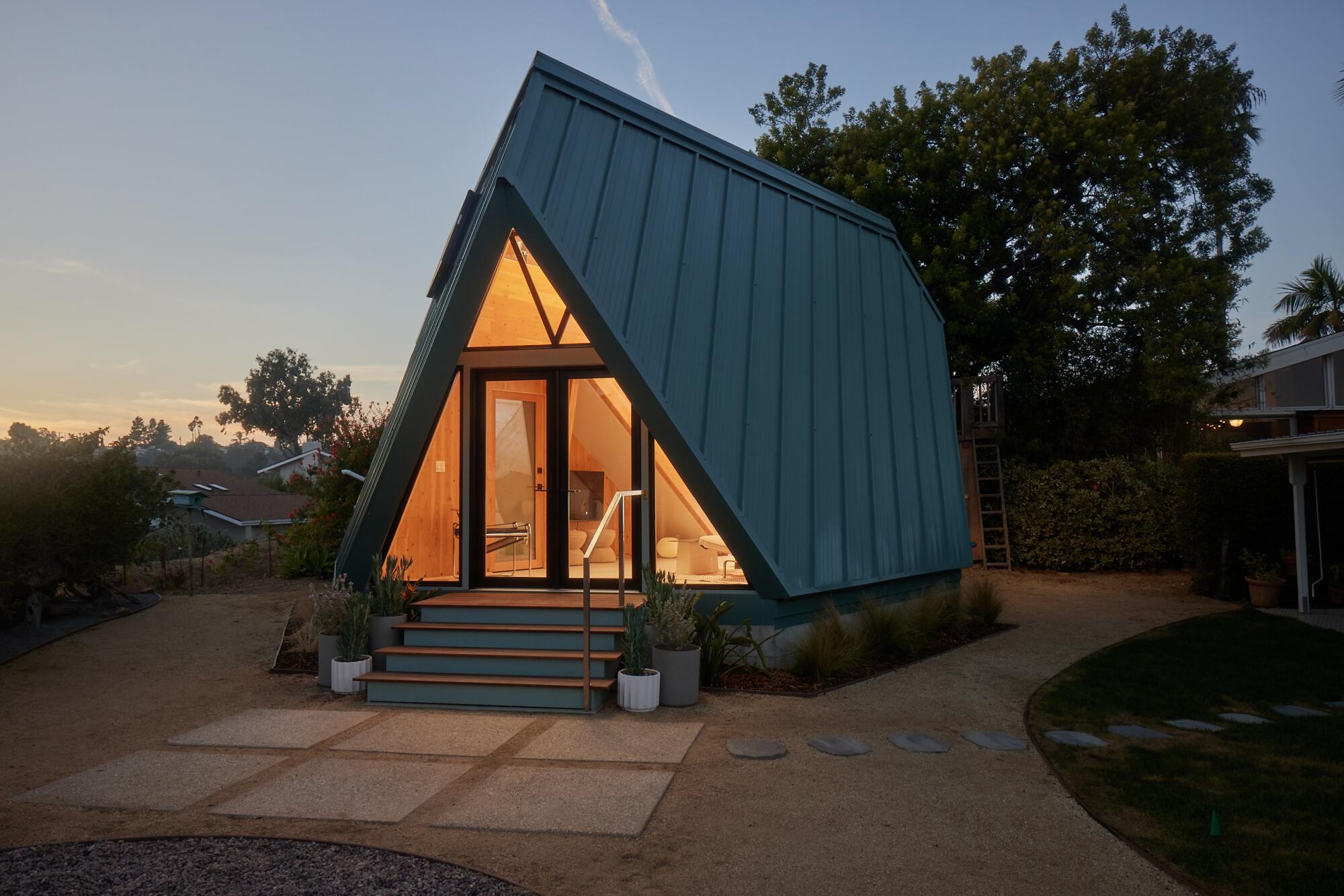Twenty-five years from today, Santa Ana winds will scream through Los Angeles on a dry autumn morning, turning a small hillside campfire into a deadly, fast-moving blaze.
At that moment, the city will spring into action.
Los Angeles knows how to weather a crisis — or two or three. Angelenos are tapping into that resilience, striving to build a city for everyone.
Satellites will team up with anemometers, pairing live aerial footage with wind patterns to tell firefighters exactly where the fire is going. Fleets of autonomous Black Hawk helicopters and unmanned air tankers will fill the skies, dropping fire retardant in the path of the flames.
Wearable technologies will guide us in the city below: “ALERT: A wildfire has been spotted 2.4 miles from your location and will reach your location in approximately 43 minutes.” Angelenos will receive a live satellite map of the blaze’s trajectory and directions for a safe evacuation.
People in threatened neighborhoods will quickly run through to-do lists: close vents, check on neighbors, etc. Some renters and homeowners will arm fire-retardant sprayers on their roofs and jam valuables into fireproof ADUs tucked in their backyards. Others will have outfitted their super-smart homes with technology that cuts down on decision-making for an even quicker get-away. Apartment safety teams will follow their well-rehearsed plans to ensure evacuation.
Then, everyone will follow their community evacuation plan by driving their electric vehicles or ride-sharing to safety, eased along by a steady flow of green lights programmed by the city to divert all traffic away from the fire. Fleets of self-driving vans will circle back through the neighborhoods, picking up any stranded residents.

Michael Kovac’s house stands among burned homes in Pacific Palisades.
(Myung J. Chun / Los Angeles Times)
The scenario might seem improbable, but according to firefighters, architects and futurists, it’s a realistic outline of what L.A.’s fire defense could look like in 2050.
Devastating fires have pummeled Southern California in the last several decades, shifting the public conversation from fire suppression to fire preparedness and mitigation as governments begrudgingly acknowledge the disasters as regular occurrences. In the wake of the deadly January fires that burned through Altadena and Pacific Palisades, many people are wondering: Can we truly fortify our city against a firestorm?
:
Architect Michael Kovac thinks we can. Kovac, a Palisades resident whose clients include celebrities, built his home to be fire-resistant knowing that, at some point, it would be subject to a firestorm.

Michael Kovac designed his home in Pacific Palisades The house is clad in fiber cement; the roof is made of fireproof TPO (thermoplastic polyolefin); the deck is made with specially treated wood for fire resistance; and a fire suppression system in the back of the house sprayed fire retardant onto the vegetation.
(Myung J. Chun / Los Angeles Times)
On Jan. 7, his entire street burned, but his house survived. Now, it serves as a blueprint for fire resistance. “We built it to be able to withstand a small fire,” Kovac said. “We never imagined our whole community would be erased.”
Kovac’s home is wrapped in fire-resistant fiber cement-panel siding. The green “living” roof is topped with grass and more than 4 inches of fire-resistant soil. The windows feature three panels of quarter-inch glass, which lessen the possibility of breakage in the face of scorching temperatures and protect the interior from radiant heat — one of the primary ways fires can enter a home.
Before fleeing the fire, Kovac loaded all his valuables into a room wrapped in concrete and equipped with a fire door capable of keeping out smoke and flames for three hours. He monitored the blaze from afar using security cameras. As the flames approached, he activated three sprinklers that sprayed fire retardant along the perimeter of the property, keeping the fire at bay.
Fire-proofing safeguards generally aren’t cheap. Fire-proof doors run from a few hundred dollars into the thousands, and fire-retardant sprinklers can cost tens of thousands of dollars, depending on the system. But Kovac also installed some DIY upgrades for next to nothing, including dollar-store mesh screens on all his vents to block embers from entering — another frequent cause of fires spreading.
Every improvement helps, but the harsh reality of the next 25 years is that across L.A., older structures that don’t comply with modern fire codes will burn. The collective hope is that by 2050, they’ll be replaced by fire-resistant homes, adding a herd-immunity defense to neighborhoods.
“The 1950s housing stock in the Palisades — smaller, older homes more vulnerable to fires — are all gone. I’m sad because I enjoyed the texture they brought, but whenever one burned, it made it likelier that the home next to it would also burn,” he said. “Now there’s a clean slate, so the neighborhood we build next will be more fire-resilient.”

The front garden at Michael Kovac’s home is filled with succulents and native plants and covered in volcanic rocks instead of mulch.
(Myung J. Chun / Los Angeles Times)
:
Ken Calligar has the same hope.
“The housing replacement cycle is slow. It upgrades every 50 years or so, with 2% of homes being replaced per year,” said Calligar, the chief executive of resilient building company RSG 3-D. “But large-scale incidents like fires or earthquakes are an opportunity for a migration to a better system.”
Calligar’s company creates insulated concrete panels that are made with fire-retardant foam sandwiched between two wire-mesh faces, which are, in turn, wrapped in concrete.
The future of fire mitigation, he said, boils down to building with non-combustible materials.
“In California, 98% of homes have wood frames. All those homeowners have a future tragedy on their hands,” he added. “You can’t knock down all of California and start new, but you can mitigate portfolio damages by making new parts of the portfolio better.”
In addition, Calliger said, “By 2050, Californians should have a fire-proof place to store their assets in case of a fire. That way, you at least have something to get back to.”
Some home builders and designers are offering fire-resilient designs as demand continues to grow in the wake of the fires. KB Home recently unveiled a 64-home fire-resilient community in Escondido equipped with covered gutters, non-combustible siding and defensible space. The Santa Monica-based architectural firm SweisKloss offers fire-rated glazes and foam-retardant sprayers on its custom-built designs. By 2050, experts say, the vast majority of home builders will offer fire-resistant homes.
There’s a reason so many California homes are built with wood: It’s relatively cheap. There are plenty of futuristic building materials — including graphene, hempcrete and self-healing concrete, which is capable of repairing its own cracks after damage — but they’re not cost-efficient for most home buyers. Even traditional concrete, which stands up to the elements better than wood, runs roughly 20%-50% more than wood for home building, and building a fire-resistant home adds tens of thousands of dollars to the building cost, according to most experts.
For Daniel López-Pérez, the solution is a return to wood. Mass timber, specifically.
In addition to being a professor of architecture at the University of San Diego and a futurist, López-Pérez is the founder of Polyhaus, a home-building startup that says it can assemble a house in three days. To prove it, he put together a small prototype in his La Jolla backyard over a weekend in February. The 540-square-foot ADU is wrapped in 60 mass timber panels made of three 1.5-inch layers of plywood sealed together.
With traditional wood construction, the wood, studs and insulation leave plenty of room for oxygen, which fuels fires. With mass timber, the three layers are sealed with no air gaps, making them much more fire-resistant. When exposed to fire, the mass timber charcoals and burns a half-inch every hour — so a 4.5-inch panel would last six or seven hours before fully burning, he said.

The 540-square-foot Polyhaus ADU was assembled over a weekend in Daniel López-Pérez’s back yard.
(Daniel López-Pérez)
“It’s like in forest fires where big, old-growth trees survive by charcoaling. The exterior chars, but the inside survives.”
Mass timber is a new trend in fire-proofing; in this year alone, there are multiple conferences across the country dedicated to the engineered wood.
Lever Architecture, a firm with offices in Portland, Ore., and L.A., has helped pioneer the use of mass timber in the U.S. Among Lever’s projects are mass timber buildings for Adidas and the Oregon Conservation Center in Portland — and a mixed-use office/retail building at 843 N. Spring St. in Chinatown.
Mass timber projects are starting to sprout up across the Southland, including a multi-family development in Silver Lake and an office-retail complex in Marina del Rey.
Though his backyard prototype is his only model so far, Polyhaus has been flooded with inquiries after the January fires. He’s been telling customers that he can put a unit up in six weeks from start to finish, with 540-square-foot units running $300,000 all-in.
For López-Pérez, the future is also about using new technology, such as the robotic arms that assemble panels, to get more out of the stuff we’re already using.
“By 2050, we’ll be mixing ancestral materials with high-tech solutions,” he said. “Think Star Wars: a lightsaber in a cave.”
In the meantime, he suggests that instead of tearing down the 1950s tinderbox houses strewn across L.A.’s fire-prone hills, we should tack mass timber panels onto their exterior or interior to give firefighters hours, instead of minutes, to try to save homes once they catch on fire.::
Mass timber is one of multiple approaches that would make Brian Fennessy’s job easier. Fennessy, who serves as fire chief of the Orange County Fire Authority, has been fighting wildfires for 47 years. But over the last few decades, as blazes penetrate deeper into cities, he’s dealing with a different kind of problem: urban conflagrations.
Wildfires burn forests or brush, but urban conflagrations are fires that burn through cities. They’re becoming more common, and the toxic fumes released when homes burn present new dangers to his squad. “These are typically wind-driven fires, and they’re driving smoke into the lungs of firefighters,” he said. “We do blood draws, and early testing shows higher levels of heavy metal.”
Firefighters have a 14% higher chance of dying from cancer than the general population, according to a 2024 study, and the disease was responsible for 66% of career firefighter line-of-duty deaths from 2002 to 2019.
He hopes 2050 brings more safety precautions for his team, such as personal respirators for every firefighter and fleets of trucks that share their location in real time for better communication between departments, and he imagines fleets of drones flying alongside firefighting aircraft.
He’s also optimistic about funding and said he’s never seen so much legislative interest in putting money toward fire services as he has in the wake of the January fires. The Los Angeles Fire Department is one of the few city departments poised to gain new hires under Mayor Karen Bass’ $14-billion spending plan released in April, which proposed adding 227 fire department jobs while cutting 2,700 jobs in other departments.
A few weeks after the January fires, a California Assembly bill was introduced to explore the use of autonomous helicopters to fight fires. The choppers, including Black Hawk helicopters traditionally used for military operations, can be remotely programmed to take off, find fires and drop water where it’s needed. By 2050, experts hope firefighting stations will have entire fleets at their disposal to limit risk to pilots during shaky weather conditions.
In March, Muon Space launched a low-orbit satellite designed to detect wildfires early. By 2030, the company expects to have a fleet of 50 satellites circling the globe.
“The next few years are a pivotal moment for both fire services and citizens,” Fennessy said. “We have to get it right.”




